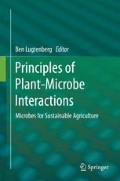Abstract
Life of microbes in the rhizosphere is best characterized as starvation for nutrients and attempts to survive. All microbes are hunting for food of which a substantial amount is supplied by the root in the form of exudate. The most successful microbes are attracted to food sources, such as to the root and to each other, by chemotaxis to specific exuded compounds. Subsequently they colonize the target organism. Specific exudate compounds can also initiate communication between organisms as the start of more specialized interactions, such as nodulation , pathogenesis, DNA transfer and the production of antibiotics . Some target organisms have developed defense reactions against such attacks which allows them to survive. All these processes are described in this chapter.
Access this chapter
Tax calculation will be finalised at checkout
Purchases are for personal use only
References
Berg G, Eberl L, Hartmann A (2005) The rhizosphere as a reservoir for opportunistic human pathogenic bacteria. Environ Microbiol 7:1673–1685
Bloemberg GV, O’Toole GA, Lugtenberg BJJ et al (1997) Green fluorescent protein as a marker for Pseudomonas spp. Appl Environ Microbiol 63:4543–4551
Bolwerk A, Lagopodi AL, Wijfjes AHM et al (2003) Interactions in the tomato rhizosphere of two Pseudomonas biocontrol strains with the phytopathogenic fungus Fusarium oxysporum f. sp. radicis-lycopersici. Mol Plant Microbe Interact 16:983–993
Bonkowski M, Villenave C, Griffiths B (2009) Rhizosphere fauna: the functional and structural diversity of intimate interactions of soil fauna with plant roots. Plant Soil 321:213–233
Chin-A-Woeng TFC, de Priester W, Van der Bij AJ et al (1997) Description of the colonization of a gnotobiotic tomato rhizosphere by Pseudomonas fluorescens biocontrol strain WCS365, using scanning electron microscopy. Mol Plant Microbe Interact 10:79–86
De Weert S, Vermeiren H, Mulders IHM et al (2002) Flagella-driven chemotaxis towards exudate components is an important trait for tomato root colonization by Pseudomonas fluorescens. Mol Plant Microbe Interact 15:1173–1180
De Weert S, Dekkers LC, Kuiper I et al (2004a) Generation of enhanced competitive root tip colonizing Pseudomonas bacteria through accelerated evolution. J Bacteriol 186:3153–3159
De Weert S, Kuiper I, Lagendijk EL et al (2004b) Role of chemotaxis towards fusaric acid in colonisation of hyphae of Fusarium oxysporum f. sp. radicis lycopersici by Pseudomonas fluorescens WCS365. Mol Plant Microbe Interact 16:1185–1191
Egamberdieva D, Kamilova F, Validov S et al (2008) High incidence of plant growth-stimulating bacteria associated with the rhizosphere of wheat grown in salinated soil in Uzbekistan. Environ Microbiol 10:1–9
Haas D, Défago G (2005) Biological control of soil-borne pathogens by fluorescent pseudomonads. Nat Rev Microbiol 3:307–319
Kamilova F, Validov S, Azarova T et al (2005) Enrichment for enhanced competitive plant root tip colonizers selects for a new class of biocontrol bacteria. Environ Microbiol 7:1809–1817
Kamilova F, Kravchenko LV, Shaposhnikov AI et al (2006) Effects of the tomato pathogen Fusarium oxysporum f. sp. radicis-lycopersici and of the biocontrol bacterium Pseudomonas fluorescens WCS365 on the composition of organic acids and sugars in tomato root exudate. Mol Plant Microbe Interact 19:1121–1126
Lagopodi AL, Ram AFJ, Lamers GE et al (2002) Novel aspects of tomato root colonization and infection by Fusarium oxysporum f. sp. radicis-lycopersici revealed by confocal laser scanning microscopic analysis using the green fluorescent protein as a marker. Mol Plant Microbe Interact 15:172–179
Lugtenberg BJJ, Bloemberg GV (2004) Life in the rhizosphere. In: Ramos JL (ed) Pseudomonas, vol 1. Kluwer/Plenum, New York, pp 403–430
Lugtenberg B, Girard G (2013) Role of Phenazine-1-carboxamide produced by Pseudomonas chlororaphis PCL1391 in the control of tomato foot and root rot. In: Chincholcar S, Thomashow L (eds) Microbial phenazines. Springer, Berlin, pp 163–175
Lugtenberg B, Kamilova F (2009) Plant growth-promoting rhizobacteria. Annu Rev Microbiol 63:541–556
Mendes R, Garbeva P, Raaijmakers JM (2013) The rhizosphere microbiome: significance of plant beneficial, plant pathogenic, and human pathogenic microorganisms. FEMS Microbiol Rev 37:634–663
Pinton R, Varanini Z, Nannipieri P (2007) The rhizosphere. Biochemistry and organic substances at the soil plant interface, 2nd edn. CRC press, Taylor and Francis Group, Boca Raton
Pliego C, Kamilova F, Lugtenberg B (2011) Plant growth-promoting bacteria: fundamentals and exploitation. In: Maheshwari DK (ed) Bacteria in agrobiology: crop ecosystems. Springer, Germany, pp 295–343
Simons M, Van der Bij AJ, Brand I et al (1996) Gnotobiotic system for studying rhizosphere colonization by plant-growth promoting Pseudomonas bacteria. Mol Plant Microbe Interact 7:600–607
van Elsas JD, Trevors JT, Starodub ME (1988) Bacterial conjugation between pseudomonads in the rhizosphere of wheat. FEMS Microbiol Lett 53:299–306
Acknowledgements
This research was supported by Leiden University as well as by numerous grants, especially from the European Commission, EET, INTAS as well as from the NWO departments of ALW, CW, and STW.
Author information
Authors and Affiliations
Corresponding author
Editor information
Editors and Affiliations
Rights and permissions
Copyright information
© 2015 Springer International Publishing Switzerland
About this chapter
Cite this chapter
Lugtenberg, B. (2015). Life of Microbes in the Rhizosphere. In: Lugtenberg, B. (eds) Principles of Plant-Microbe Interactions. Springer, Cham. https://doi.org/10.1007/978-3-319-08575-3_3
Download citation
DOI: https://doi.org/10.1007/978-3-319-08575-3_3
Published:
Publisher Name: Springer, Cham
Print ISBN: 978-3-319-08574-6
Online ISBN: 978-3-319-08575-3
eBook Packages: Biomedical and Life SciencesBiomedical and Life Sciences (R0)

